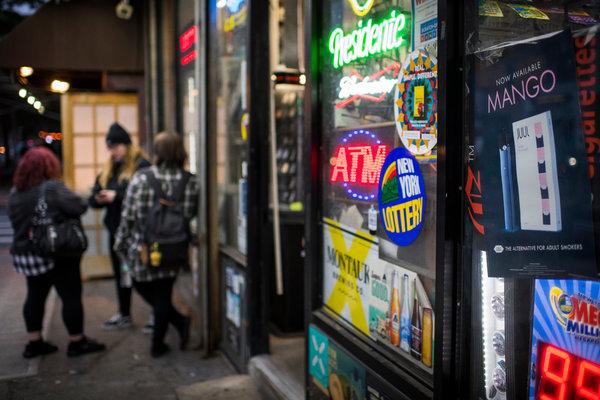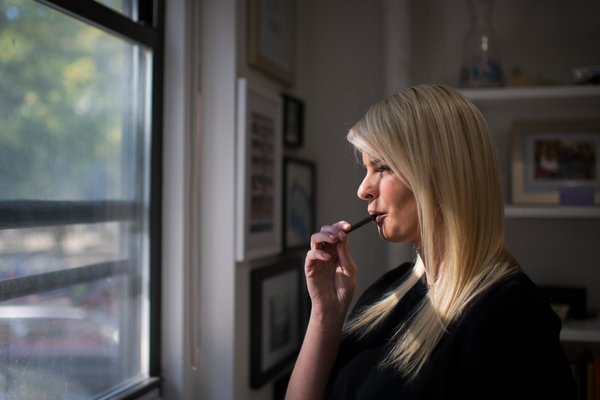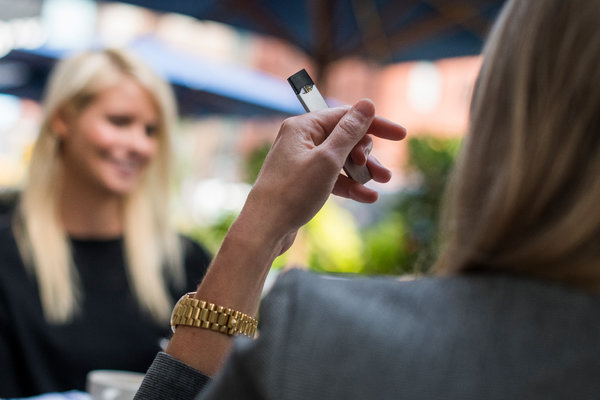READING, Mass. — He was supposed to inhale on something that looked like a flash drive and threw off just a wisp of a cloud? What was the point?
A skeptical Matt Murphy saw his first Juul at a high school party in the summer of 2016, in a suburban basement crowded with kids shouting over hip-hop and swigging from Poland Spring water bottles filled with bottom-shelf vodka, followed by Diet Coke chasers.
Everyone knew better than to smoke cigarettes. But a few were amusing themselves by blowing voluptuous clouds with clunky vapes that had been around since middle school. This Juul looked puny in comparison. Just try it, his friend urged. It’s awesome.
Matt, 17, drew a pleasing, minty moistness into his mouth. Then he held it, kicked it to the back of his throat and let it balloon his lungs. Blinking in astonishment at the euphoric power-punch of the nicotine, he felt it — what he would later refer to as “the head rush.”
“It was love at first puff,” said Matt, now 19.
The next day, he asked to hit his friend’s Juul again. And the next and the next. He began seeking it out wherever he could, that irresistible feeling — three, sometimes four hits a day.
So began a toxic relationship with an e-cigarette that would, over the next two years, develop into a painful nicotine addiction that drained his savings, left him feeling winded when he played hockey and tennis, put him at snappish odds with friends who always wanted to mooch off his Juul and culminated in a shouting, tearful confrontation with his parents.
He would come to hate himself for being dependent on the tiny device, which he nicknamed his “11th finger.” Yet any thought of quitting made him crazy-anxious.
Experiences like Matt’s have placed Juul at the epicenter of a national debate. On one side stand longtime adult smokers who celebrate the device as the aid that finally helped them quit smoking. On the other are teenagers who have never smoked a cigarette but who have swiftly become addicted to Juul’s intense nicotine hits.
This week the Food and Drug Administration tried to walk a careful line between the two, announcing restrictions that only permit stores to sell most flavored e-cigarettes from closed-off areas that are inaccessible to customers under 18. But it stopped short of previous threats to ban stores from selling flavors altogether.

The agency has acknowledged that it was caught flat-footed by a tidal wave of teenage vaping. According to the 2018 National Youth Tobacco Survey, released this week, the number of middle and high school students who currently vape has soared to about 3.6 million. On Dec. 5, the F.D.A. will hold a public hearing about potential therapies to address teenage nicotine addiction.
The easily concealable Juul, which had barely come on the market when Matt tried it, has become wildly popular with teenagers and now accounts for more than 70 percent of the e-cigarette sales in the United States. The F.D.A. is investigating whether the company that makes it, Juul Labs, intentionally marketed its devices to youth. On Tuesday, under increasing pressure, Juul announced it would stop its social media promotions and suspend store sales of many of its flavors — except for tobacco, menthol and mint (Matt’s favorite).
One pod, or cartridge, of Juul’s flavored liquids contains an amount of nicotine roughly equivalent to a pack of cigarettes. That can be a benefit to smokers who get the nicotine fix they desperately seek without the carcinogenic smoke that comes from burning tar-laden tobacco. But the impact on teenagers, whose brains are still developing, is troubling.
“Nicotine may disrupt the formation of circuits in the brain that control attention and learning,” said Dr. Rachel Boykan, a clinical associate professor of pediatrics at Stony Brook University School of Medicine and an executive member of the American Academy of Pediatrics’ section on tobacco control. “And there is a higher risk of them subsequently becoming tobacco smokers.”
The science about long-term effects of the other chemicals and small metals in the vaporized liquids is unsettled, not only because formulations vary widely and are often undisclosed, but because e-cigarettes have not been around long enough to study thoroughly.
Some research suggests disturbing risks. A joint project between Duke and Yale’s Tobacco Center of Regulatory Science, published this fall in the journal Nicotine and Tobacco Research, found that when certain popular flavors are added to a common solvent in the vaping liquids, they produce chemicals that irritate airways and lungs. A 2016 study in the journal Chest said that smoking e-cigarettes had an effect on the heart and arteries which, while was not as pronounced as that of combustible cigarettes, was still distinctive.
Perhaps what alarms public health experts most about e-cigarettes generally and Juul in particular is nicotine which, when vaporized, is absorbed by the body within seconds, much faster than when delivered by chewing gum or patches. Its potent addictive properties, doctors say, can be most pronounced in teenagers.
******
After a few weeks of bumming daily hits from friends (called “fiending”), Matt went on a family vacation out West. On his second day without a Juul, he found he wanted one desperately. On the third, he couldn’t take it anymore.
He searched Juul’s website to find a local store that sold it, and ordered an Uber to get there, mumbling a nonchalant excuse to relatives. Between the cost of the ride service plus the Juul “starter” kit, he spent $ 100 to sate his need.
Soon, he escalated to a daily pod, sometimes more. He was spending $ 40 a week, draining his Christmas and birthday money, and his paycheck from his part-time job at Chili’s.
Matt doesn’t come across as a cool alpha. He’s an easy, approachable kid with a certain sweetness, voted “best personality” by his high school classmates. Focused on achieving academic and financial success, he stayed away from marijuana, alcohol and cigarettes. The Juul, he thought, was a harmless way to look like an edgy risk-taker.
It became stitched into his social identity, and bound him to his buddies, who would ride around town hitting their Juuls in one friend’s 2002 Volvo. By the time he graduated from high school in 2017, four of his five closest friends were also daily Juulers.
He and other athletes noticed they would get out of breath more quickly. “We called it ‘Juul lung,’ ” Matt said. “We knew it lowered our performance but we saw that as a sacrifice we were willing to make.”
There is an art and artifice to being a teenage Juuler, Matt explained during numerous long conversations, including one over a recent lunch at a local pizza shop. You have to scope out which convenience stores will card you and which will look away, so long as you pay their inflated prices.
Near Matt’s house in Reading, a middle-class Boston suburb, there are two convenience stores on West Street. The first won’t sell you e-cigarettes unless you are 21. The second was just over the town line in neighboring Woburn, where the legal age until recently was 18. Turned away in Reading, Matt and his friends would simply saunter down the block, where they could pass scrutiny.
What he had initially derided as Juul’s pitiful wisp of nearly odor-free vapor turned out to be a great advantage. Teachers were clueless. If his parents walked into his room five seconds after he exhaled, they wouldn’t know. “The Juul was super, super sneaky and I loved it,” he said.
But by the time he got to college, he began to admit to himself he had a problem. He was majoring in biochemistry at the University of Vermont and feeling overwhelmed by the workload; the Juul was his only stress-escape. To limit his use, he kept it in his dorm room rather than carry it with him.
But soon, he realized: “All I wanted was to be in my room.”
He had 40 minutes between classes: Ten minutes, bike to the dorm. Hit Juul, 20 minutes. Ten minutes, bike to next class. Repeat.
By now his vaping was about maintenance, keeping the craving irritability at bay. He knew things had gotten just ridiculous, but there was nothing to be done about it. He even fixed a Velcro strip on the dresser next to his dorm room bed and stuck the Juul on it, so that as soon as he opened his eyes in the morning he could just reach up for a hit: first, best, only head rush of the day.
One girl on his dorm hall sold Juul pods from stock she had bought from a guy who ordered armloads on the internet. Unlike back home in high school, college students vaped in public everywhere — in lecture halls, at hockey games, in the dorm common rooms.
“Matt was open about wishing he didn’t do it,” said Tucker Houston, his freshman roommate. “It was a constant battle for him. People would tell him that they’d want to buy a Juul and he’d be like, ‘No! You don’t want to, it’s not cool, it’s not fun.’ He became known as the juuling anti-Juul advocate.”
This past summer, Matt returned home to work construction for his father, a building contractor. In the full sway of his addiction, he stuck the empty pods in his backpack so they wouldn’t be spotted in the household trash. He hid the Juul in his bedroom, doing without it on the job for up to six hours at a stretch.
That was rough.
“But I knew if my parents caught me, I couldn’t do it again, and that represented a future of not doing it,” Matt said. “I rationalized that it was better to do without it briefly, than forever.”
Then he found that the delayed gratification from leaving it at home was fantastic. “If you wait an hour, it feels great. But if you wait five hours, it feels unbelievable.”
At the end of the day, he would take a long, two-second draw, and keep it in his lungs, a practice called “zeroing,” because his body absorbed all the vapor, exhaling none. He’d zero it four or five times, feel dizzy, blink about 10 times, and then be fine.
One day, Matt’s mother walked into his room to collect his dirty laundry. There was his backpack, unzipped, open.
The confrontation with his parents was epic.
David Murphy, Matt’s father, was startled by the extent of Matt’s Juul concealment. He hadn’t suspected something was amiss. Matt’s behavior never seemed appreciably altered.
The vaping had to end, Mr. Murphy ordered. “I said, ‘Nicotine is a lifelong burden. There’s a big company with its hand in your pocket, distracting your thought process continuously. Juuling is a huge undocumented risk. Now, how do we come back together as a family and solve this problem?”
Two hours into the tearful conversation, Matt concluded: “I could not justify the addiction anymore. And I realized my parents were my allies. Because I wanted to stop and they wanted me to stop.”
*********
Because Juul is so new, there is no consensus protocol for how teenagers should withdraw. Matt devised a weaning regimen: every two hours, five short hits. Then longer breaks, fewer hits.
One June day he was riding shotgun in the Volvo with his old friends. As he was about to take a scheduled hit, he grew despairing and exasperated. He had tried quitting before but it had never worked; would he always be chained to this gadget? Impulsively, he tried to throw the Juul out the car window, but the window stuck. So he abruptly yanked back the sunroof and heaved it to the street.
One friend, sitting in the back, cheered and pumped his fist. But another scowled — he would happily have taken Matt’s Juul.
“I felt strong for five minutes,” Matt said. “And then I felt really weak. I only realized the magnitude of my addiction when I stopped.”
Nicotine withdrawal, he said, was hell. He was overtaken with bouts of anxiety. Who was he without his 11th finger? He would get the shakes, curl up in his bed, overcome with a sense of powerlessness.
“When Matt withdrew, he’d flip out a lot, especially when other people had it around him,” said Jared Stack, a friend since elementary school. “They wouldn’t stop doing it just because he had. They didn’t care — because they were addicted too.”
It was the whirring, the purring, the sound of their Juuls firing up, that would trigger Matt. Yet avoiding his friends was inconceivable.
After three weeks, the worst of it passed. Even still, Matt can tick off to the day how long it’s been since he stopped on June 6: 163 days as of Friday.
He transferred to the University of Massachusetts in Lowell, majoring in business and living at home. Whenever he feels the Juul urge now, he tells himself, “I’d have to go through the whole horrible dark time that is being addicted and then quitting.”
His eyes brightened as he gulped the last of his pizza, long limbs splayed everywhere. Instead, he said, he tries to help friends who want to quit. “They text me all the time when they’re trying. They’ll say, ‘Did you experience this?’
“And I say, ‘Yes,’ because I want them to know I understand,” he said. “And then I tell them, ‘But it gets better.’ Because it does.”
[Like the Science Times page on Facebook. | Sign up for the Science Times newsletter.]


